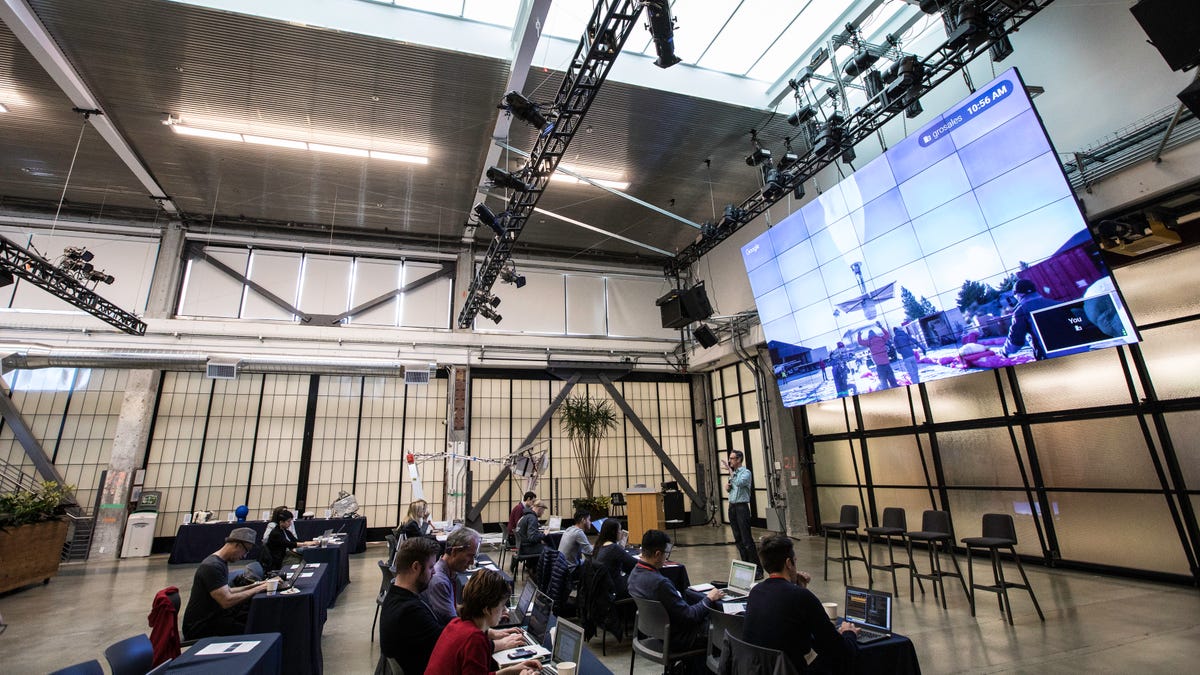Project Loon, Alphabet's Wi-Fi-beaming moon shot, still flying
The company can now better control its high-flying balloons that aim to blanket remote areas with internet signals. We get a peek inside the Loon lab.

Along the fringes of Google 's Silicon Valley headquarters, in a nondescript, beige-bricked building named "The Rails," a few guys wearing shark slippers stand in a dark room on a long table that looks like a glowing runway.
They are meticulously examining what look like long, clear trash bags. They're actually pieces of large balloons, and the workers are scrutinizing them for stress and damage. (The shark slippers are so they don't damage them further.)
The balloons are the cornerstone of Project Loon, Google's attempt to connect remote populations to the internet by beaming down Wi-Fi from balloons flying way up in the stratosphere to serve, essentially, as airborne cell towers. On Thursday, the company invited a handful of reporters on a quick tour of the lab where the machinery for the 40-foot-tall balloons is made. (Photos and video recordings were prohibited, though.)
Workers in Google's forensics lab inspecting the balloons in December.
The scene underscores one simple but obvious thing: Balloons floating through the stratosphere are unpredictable, and anything can happen to them.
Alphabet, Google's parent company, said it found a way to make the balloons a little less unpredictable. It's using artificial intelligence to help improve the balloons' navigation algorithms. That means they can better control a balloon's ability to loiter in place instead of drifting off.
Now fewer balloons can be clustered around a specific place where people need internet connectivity. So instead of scattering hundreds of balloons across the globe, the company can send 10 to 30 balloons to beam Wi-Fi to a smaller region. Another benefit is they don't have to waste the technology over oceans, where there aren't any people.
"We've been working to apply more and more machine learning to essentially make the balloons smarter," Astro Teller, head of X, which handles the company's ambitious moon shot projects, said after the tour. The 46-year-old scientist, sporting a salt-and-pepper ponytail and goatee, made his presentation while on Rollerblades (a favorite mode of transportation for Google's co-founders Larry Page and Sergey Brin.)
That's allowed Loon to keep costs "flat," though Teller wouldn't give specifics.
'Keep flying'
Loon is still in the testing phase. Last year, X, which developed Project Loon, announced it was working with the Indonesian government to try to bring the balloons to that country, but it still hasn't begun a pilot test with real users. Alphabet's business model is to partner with local telecommunications companies that use Loon's technology, instead of dealing with consumers directly.
Teller hopes to launch a pilot test within the next few months, though he doesn't know yet where it will be.
Almost 4 billion people still don't have access to the Web, according to the International Telecommunication Union, a United Nations agency. Changing that could have staggering implications for emerging countries. The internet could give rural villages video access to remote doctors and classrooms, for example. It could even help break the cycle of poverty, according to the Bill and Melinda Gates Foundation, by allowing the rural poor to send and receive money right from their phones.
Google's not the only Silicon Valley giant set on bringing the internet to the masses. Facebook has a similar project it's testing. They're using a drone called Aquila, with the wingspan of a Boeing 737, to blanket the earth with Wi-Fi signals.
Astro Teller, head X, is in charge of Alphabet's most ambitious projects, or "moon shots."
For those tech giants, this isn't just about altruism. It's good business. The more people they can get online, the more people they can persuade to use their services -- like search, maps and YouTube for Google, and WhatsApp, Instagram and, well, Facebook for Facebook.
More people for these free services means they're able to collect more data to woo advertisers.
A Project Loon balloon on display in New Zealand in 2013.
The lab tour comes as Alphabet is facing increased scrutiny over its moon shots, the company's name for big, ambitious projects. Over the past few months, a number of moon shots have been shut down or scaled back. In October, Alphabet said Fiber, an attempt at supercharging internet speeds, would pause expansion, though it will continue operating in the eight cities where it's already in place.
And on Wednesday, Alphabet reportedly named a new leader for Access, the division Fiber is a part of, though "several hundred" workers will be switching back to work at Google, according to Bloomberg. (I'm still waiting on an answer on that.)
Alphabet has also reportedly scaled back its drone operations. The aircraft were originally supposed to be other ways the company could spread internet access to remote regions. Instead, it's reportedly focusing more on drones for deliveries, like shuttling pizza and groceries to consumers.
As for Loon, it still has a long way to go. "The whole global connectivity problem? Definitely not solved," said Sal Candido, the engineer responsible for the balloons' navigation software. "Loon? Definitely not solved either."
"But we're going to keep testing," he added. "We're going to keep flying."
It's Complicated: This is dating in the age of apps. Having fun yet? These stories get to the heart of the matter.
Technically Literate: Original works of short fiction with unique perspectives on tech, exclusively on CNET.

